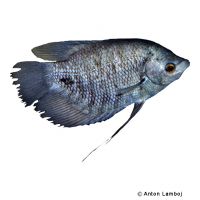Giant Gourami (Osphronemus goramy)
| Giant Gourami Osphronemus goramy | |
|---|---|
| Name | Giant Gourami |
| Name Lat. | Osphronemus goramy |
| Synonym | Osphronemus gourami |
| Family | Gouramies |
| Family lat. | Osphronemidae |
| Order | Labyrinth Fishes |
| Order lat. | Anabantiformes |
| Origin | Southeast Asia |
| Habitat | Rivers, lakes |
| Diet | Omnivore |
| pH | 6.0-8.0 |
| Behavior | ♂ territorial |
| Keeping | Individual, pair |
| Care Level | Experts only |
| Reproduction | Bubble nest builder |
| Breeding | Moderately difficult |
| Life Span | 15-20 years |
| Protection | No |
| Metric Units | |
| Size | 40-70 cm |
| Temperature | 20-25 °C |
| Hardness | 5-25 °dH |
| Aquarium | 700 l |
| US Units | |
| Size | 16"-28" |
| Temperature | 68-77 °F |
| Hardness | 89-445 ppm |
| Aquarium | 200 gal |
Distribution and habitat
Originally, the giant gourami come from the Great Sunda Islands (Indonesia). There they live in large, slow-flowing rivers, lakes and ponds with partly dense vegetation.
Maintenance
The well-structured large tank should have a robust border planting and offer hiding places from large roots and stones as well as plenty of swimming space. A substrate of fine gravel or sand, some subdued light (floating plants) and a weak current is ideal.
No ammonia, ammonium and nitrite should be detectable, the nitrate value should not exceed 100 mg/l. To ensure the water quality and oxygen content, a filter and heater adapted to the aquarium size is required, as well as lighting for the species-appropriate day-night rhythm of the animals.
Diet
They are omnivores and not picky with their food. The food supply consists of live or frozen food, such as mysis, tubifex, mosquito larvae, crustaceans and worms, plus commercially available frozen special food mixtures. In addition, they require plant food, e.g. in the form of scalded lettuce leaves and fruits, supplemented with dry food (flakes, granules, pellets) with a high vegetable content (e.g. spirulina, kelp).
A regular and varied diet promotes health and increases resistance.
Behaviour and compatibility
Juveniles are suitable for community tanks with larger fish. Males become incompatible with each other after sexual maturity
In principle, only mutually compatible fish species with similar demands on water quality and water temperature may be socialized.
Sex dimorphism
Adult males are recognizable by the bulky head with large frontal boss and thicker lips, and the tips of the dorsal and anal fins are pointed.
Reproduction and breeding
During the spawning season the fins of the males turn black, those of the females orange. The male builds a hemispherical, downward open foam nest with the inclusion of plant parts and takes over the brood care. After mating, the oval eggs, almost 3 mm in size (more than 3,000 pieces), are introduced into the nest. It is recommended to separate the female after egg laying. The young fish are cared for by the male for about 14 more days.
Fry must be fed several times a day with special rearing food. Breeding is hardly possible in a community tank, as the fry are easy prey.
Important
They have an additional respiratory organ, the so-called labyrinth (suprabranchial organ) with which they breathe atmospheric air and can suffocate if this is not possible. The air temperature in the breathing area must not be below the water temperature!
The thread-like extended ventral fins also serve for chemical perception (taste stimuli).
Today they are introduced in many tropical countries of all continents as useful fish.
The well-being of the fish should be checked regularly. Temperature should be checked daily, pH, hardness and nitrate levels should be checked at least every 14 days. Regular partial water changes are recommended, even when contaminant levels have not yet reached the upper limit. Sudden changes in water quality should be avoided. Newly introduced fish must be accustomed slowly to the water in the aquarium.
Further literature can be found in your pet store.
References
Text: petdata; Image: Anton Lamboj
Source: BMELV (1998): Tierschutzgutachten - Haltung von Zierfischen (Süßwasser); RIEHL & BAENSCH (2006): Aquarien Atlas Bd. 1, Mergus Verlag; ENGELMANN (2005): Zootierhaltung - Tiere in menschlicher Obhut: Fische, Verlag Harri Deutsch
- Gemäß § 21 Abs. 5 Tierschutzgesetz idgF
